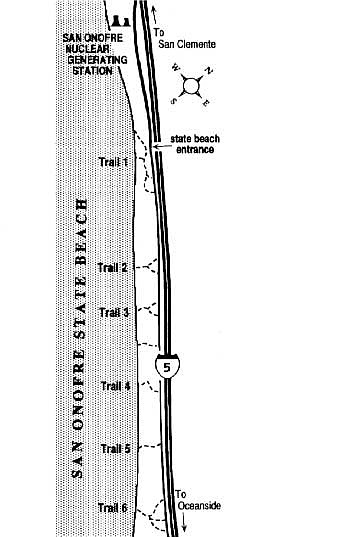 Facebook
Facebook
 X
X
 Instagram
Instagram
 TikTok
TikTok
 Youtube
Youtube
Just below one of San Diego County's few campgrounds dull enough to be insipid lies one of the more agreeably wild stretches of beach to be found in Southern California. Coastward of the 300 tent and RV campsites and assorted parking lots partitioned amid the four-lane bed of the old, abandoned Highway 101, the land falls in jagged disarray to sand and surf some 200 vertical feet below. On top, the white noise of automobiles punctuated by the diesel groans of semis and the occasional thunder of commuter trains never quits. Below, nothing -- other than the fortress-like San Onofre power plant visible in the distance -- disturbs the beachgoer's reverie of curling breakers, shifting sands, and salt-laden breezes.
San Onofre State Beach lies on a sliver of Camp Pendleton Marine Corps property leased to the state for public recreation. To get there, take the Basilone Road exit from I-5 (just short of the Orange County line), and backtrack south on the west-side frontage road (a segment of the old coast highway) for three miles to the entrance. The next three miles of the old highway roadbed make up the campground.
Eight dirt roads or paths descend through ravines or breaks in the bluff wall to reach the white-sand beach below. On the way down any of these paths, keep an eye out for dolphins cavorting in or just beyond the surf.
The steepness of the sand on most of San Onofre's beach, the accumulation of pebbles in the intertidal zone, plus the tendency of the fast-breaking waves to hurl pebbles make this a somewhat tricky place to swim or body surf. Board surfers, out farther in deeper water, fare better.
Hiking along the beach is rewarding here because of the relatively remote feel of the place. You can look at the endless variations in form of the eroded bluffs, especially at the north end at a place called Echo Arch, site of the former Echo Arch walk-in campground. The "arch" refers to the broad, concave surface of the vertical bluff behind the beach.
North of Echo Arch, along a sculpted cliff wall, you can seek out the trace of the Cristianitos Fault. Look for the obvious, diagonal contact between two differing rock types. The fault, a probable diverging strand of the Rose Canyon Fault, was of concern during the siting of the nuclear power plant, just one mile north. Geologists believe this particular strand has been inactive for the past 125,000 years.
After Labor Day the summertime crowds mostly evaporate, yet water and air temperatures remain moderate for another several weeks. The night and morning low clouds that hang about the coast in early summer tend to become scarcer, making the beach sunnier and certainly warmer than it is in early summer.


Just below one of San Diego County's few campgrounds dull enough to be insipid lies one of the more agreeably wild stretches of beach to be found in Southern California. Coastward of the 300 tent and RV campsites and assorted parking lots partitioned amid the four-lane bed of the old, abandoned Highway 101, the land falls in jagged disarray to sand and surf some 200 vertical feet below. On top, the white noise of automobiles punctuated by the diesel groans of semis and the occasional thunder of commuter trains never quits. Below, nothing -- other than the fortress-like San Onofre power plant visible in the distance -- disturbs the beachgoer's reverie of curling breakers, shifting sands, and salt-laden breezes.
San Onofre State Beach lies on a sliver of Camp Pendleton Marine Corps property leased to the state for public recreation. To get there, take the Basilone Road exit from I-5 (just short of the Orange County line), and backtrack south on the west-side frontage road (a segment of the old coast highway) for three miles to the entrance. The next three miles of the old highway roadbed make up the campground.
Eight dirt roads or paths descend through ravines or breaks in the bluff wall to reach the white-sand beach below. On the way down any of these paths, keep an eye out for dolphins cavorting in or just beyond the surf.
The steepness of the sand on most of San Onofre's beach, the accumulation of pebbles in the intertidal zone, plus the tendency of the fast-breaking waves to hurl pebbles make this a somewhat tricky place to swim or body surf. Board surfers, out farther in deeper water, fare better.
Hiking along the beach is rewarding here because of the relatively remote feel of the place. You can look at the endless variations in form of the eroded bluffs, especially at the north end at a place called Echo Arch, site of the former Echo Arch walk-in campground. The "arch" refers to the broad, concave surface of the vertical bluff behind the beach.
North of Echo Arch, along a sculpted cliff wall, you can seek out the trace of the Cristianitos Fault. Look for the obvious, diagonal contact between two differing rock types. The fault, a probable diverging strand of the Rose Canyon Fault, was of concern during the siting of the nuclear power plant, just one mile north. Geologists believe this particular strand has been inactive for the past 125,000 years.
After Labor Day the summertime crowds mostly evaporate, yet water and air temperatures remain moderate for another several weeks. The night and morning low clouds that hang about the coast in early summer tend to become scarcer, making the beach sunnier and certainly warmer than it is in early summer.
